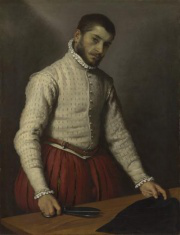Giovanni Battista Moroni - Royal Academy of Arts

Moroni's The Tailor
Giovanni Battista Moroni - Royal Academy of Arts - Until 25th January 2015
Innumerable visitors to the National Gallery have, over the years, paused to admire a portrait of a sixteenth-century tailor. This handsome, bearded man, pauses from cutting some black cloth to fix the viewer with an alert, and penetrating gaze. His head is cocked at an angle as though he has momentarily paused from his work. He is utterly serene.
The handsome tailor, who wears a fashionable, pricked jacket, quite possibly made by himself, seems to afford us just a privileged second of intimacy. He is still holding his sharp scissors in his right hand, and the cloth in his left.
We are treated to a supreme execution of realism and individuality. As so often in Moroni’s portraits, the tailor, a rare example of a working man in early modern portraiture, emerges from a monochrome background, subtly lit, to absolutely animate and dominate the foreground.
The Royal Academy’s superb exhibition is the first large-scale survey of one of the greatest portraits of the Italian Cinquecento.
Moroni (c.1520/24-1579/80) hailed from Albino, in the northern Italian Alps. While Titian allegedly recommended him as an artist who painted portraits ‘from nature’, Vasari omitted him from his Lives of the Artists, and his reputation fluctuated over the centuries.
The RA exhibition certainly succeeds in celebrating his genius. Not only do we see a great many ravishing portraits, so utterly fresh and real, but also many examples of his religious art which has received less attention.
The portraits are often full-length celebrations of aristocrats in all their finery, including two female poets. Moroni has a penchant for including broken pillars in some of these. His attention to costume detail is as successful as his attention to anatomy and physiognomy.
His smaller ‘bust’ portraits are full of a felt presence and intense liveliness. His subjects, whether a Lateran canon gazing over his shoulder and down at us, half-smiling, or a merry-looking courtier, or the steely lady in black, are veritable characters.
As for his religious works, these are a revelation. Often the donors are in the foreground. And it is as if they are contemplating the biblical scene which unfolds behind them. This is the case of the Gentleman in Contemplation of the Baptism of Christ.
Moroni attended the early years of the Council of Trent which formulated the spirituality of the Counter-Reformation. He also seems conversant with the meditative practices, such as compositio loci (the composition of place), of St Ignatius of Loyola. In the beautiful Last Supper altarpiece, a serene Christ, surrounded by animated if distracted apostles, gazes directly out at the viewer as he blesses the bread he proffers in front of him. Directly behind Jesus, a priest, identified as Romano di Lombardia, the parish priest of the altar-piece church, carries a cruet of wine and wears over his shoulder a white stole, which is worn of course during the celebration of the Eucharist. (Here is a pictorial promulgation of the doctrine of transubstantiation). The priest also stares straight out at the viewer. In this picture, Moroni has gone a step further than simply alluding to a patron’s meditative identification with the sacred scene. Here, di Lombardia has actually stepped into the Biblical narrative. Obeying Christ’s own great instruction, he is the servant to his Lord.
You have just a week left to see this exhibition.
For more information see: www.royalacademy.org.uk/exhibition/giovanni-battista-moroni
Dr Philip Crispin
Lecturer in Drama, University of Hull


















